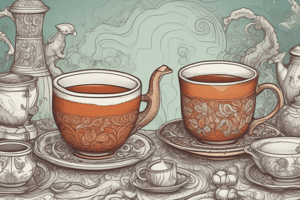Podcast
Questions and Answers
What characterizes glandular hairs in the context provided?
What characterizes glandular hairs in the context provided?
- Short and stiff with a cylindrical shape
- Multicellular with a clavate head (correct)
- Uniformly glandular throughout the stem
- Single-celled with a tapered end
Where is the perimedullary phloem located in relation to the xylem?
Where is the perimedullary phloem located in relation to the xylem?
- Interspersed within the xylem
- Above the xylem in the stem
- On the outer side of the xylem
- On the inner side of the xylem (correct)
Which feature is associated with the vascular bundles mentioned?
Which feature is associated with the vascular bundles mentioned?
- Collateral vascular bundles with single layers of phloem
- Closed vascular bundles that lack phloem
- Collateral vascular bundles with perimedullary phloem (correct)
- Open vascular bundles with multiple types of phloem
What type of hair is described to have a club-shaped head?
What type of hair is described to have a club-shaped head?
Which of the following descriptions best fits the properties of the vascular structures mentioned?
Which of the following descriptions best fits the properties of the vascular structures mentioned?
What is the relationship between oxidation time and phlobaphenes production in tea?
What is the relationship between oxidation time and phlobaphenes production in tea?
What color indicates the presence of phlobaphenes in tea?
What color indicates the presence of phlobaphenes in tea?
Which compound has high antioxidant activity, according to the content?
Which compound has high antioxidant activity, according to the content?
What is the primary result of oxidation or fermentation processes in terms of antioxidant activity?
What is the primary result of oxidation or fermentation processes in terms of antioxidant activity?
During the oxidation of tea, which pigment starts off as colorless and transitions to a yellow hue?
During the oxidation of tea, which pigment starts off as colorless and transitions to a yellow hue?
Flashcards are hidden until you start studying
Study Notes
Tea Leaf Characteristics
- Tea leaves have glandular hairs with short or long stalks and multicellular, club-shaped heads (clavate hair).
- Phloem is located on the inner side of the xylem, known as perimedullary phloem with collateral vascular bundles.
Tea Oxidation Process
- Tea leaves contain oxidase enzymes that act on polyphenols, resulting in the formation of phlobaphenes.
- Polyphenols exhibit high antioxidant activity, while phlobaphenes have lower antioxidant activity.
- Polyphenols are colorless to yellow, while phlobaphenes are reddish to brown, contributing to the color of tea.
- Higher levels of oxidation lead to a greater production of phlobaphenes, resulting in darker tea.
Green Tea Production
- Green tea undergoes minimal oxidation.
- Leaves are rapidly dried to inactive the oxidase enzyme, preserving high polyphenol concentration.
Tea Leaf Active Constituents
- Tea leaves are rich in antioxidants and anti-inflammatory substances.
- The high concentration of phenolic compounds in tea leaves contribute to its health benefits, such as disease prevention and cognitive function support.
- Tea leaves have antiseptic properties and have been used in lozenges and other pharmaceutical preparations.
Studying That Suits You
Use AI to generate personalized quizzes and flashcards to suit your learning preferences.




